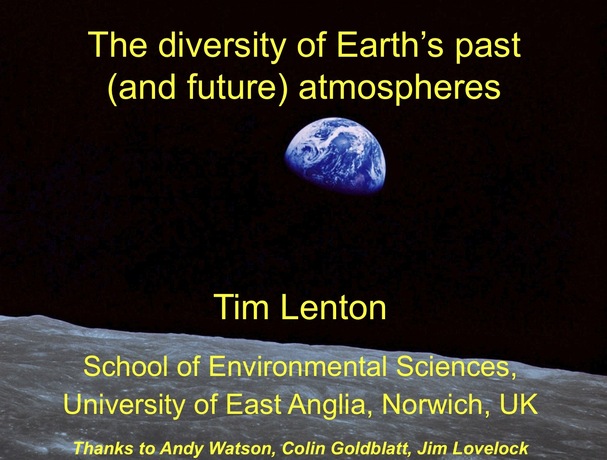Living planets > Tim Lenton

If initial loading stalls, switch to the Flash version.
The diversity of Earth'spast and future atmospheres
Tim Lenton
University of East Anglia, UK
Help



Abstract: As James Lovelock pointed out in 1965, the extreme thermodynamic disequilibrium of the Earth’s present atmosphere reveals that life is abundant at the surface. The search for life on extra-solar planets might best be achieved by looking for atmospheric disequilibrium. At the same time, Lovelock cautioned not to assume that life elsewhere would look anything like that on the Earth. By extension, the atmospheres of other living planets could be quite different to our own. Indeed, by looking back at Earth history we can get a sub-sample of some of the alternative atmospheres that a thriving biosphere can support. The talk will review what we know about those past atmospheres, and what models project for the future atmosphere of the Earth. Oxygen is of particular interest as it is widely assumed to be a bio-signature – although really it is the co-existence of methane and other reduced gases with it that is most revealing of life. Importantly, the current oxygen-rich (15-30%) atmosphere is the exception rather than the rule – it has only been present for about a tenth of the planet’s history. Oxygen has risen in a series of steps. Prior to the origin of oxygenic photosynthesis, roughly 2.7 billion years ago, it was a negligible constituent. Then for hundreds of millions of years, oxygen flickered around a part per million of the atmosphere and methane was more chemically dominant. At the 'Great Oxidation', 2.4-2.2 billion years ago, oxygen increased by orders of magnitude and the ozone layer formed, in what appears to have been a permanent, irreversible transition. Still oxygen probably remained only about 1% of the atmosphere – for the next 1.5 billion years we really have rather poor constraints. Recent evidence suggests several ‘Lesser Oxidations’ happened between about 700 and 400 million years ago. Finally we get the charcoal record reliably indicating oxygen above 15% of the atmosphere for the past 370 million years. In the long-term future, oxygen is forecast to decline. Generalising beyond the Earth reveals two key points: (1) The process of oxygenic photosynthesis, which is absolutely necessary to produce an oxygen-rich atmosphere, is extremely difficult to evolve and might only be expected to arise on a tiny fraction of planets that have evolved prokaryote life. (2) Even where oxygenic photosynthesis does evolve, there is no guarantee that a Great Oxidation will occur – it could be delayed beyond the habitable lifetime of a terrestrial planet. Consequently, we have to conclude that looking for oxygen is not the best way to look for life elsewhere.
Additional materials: PDF of slides
ExoClimes 2010, Exeter, Friday 10th Sep 2010
Additional materials: PDF of slides
ExoClimes 2010, Exeter, Friday 10th Sep 2010
